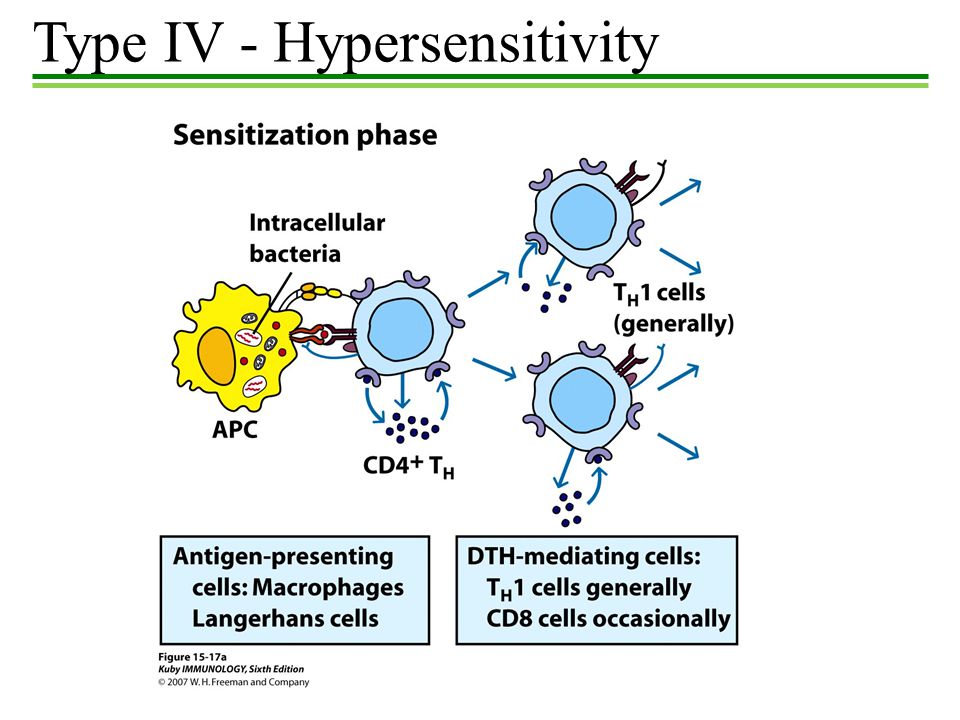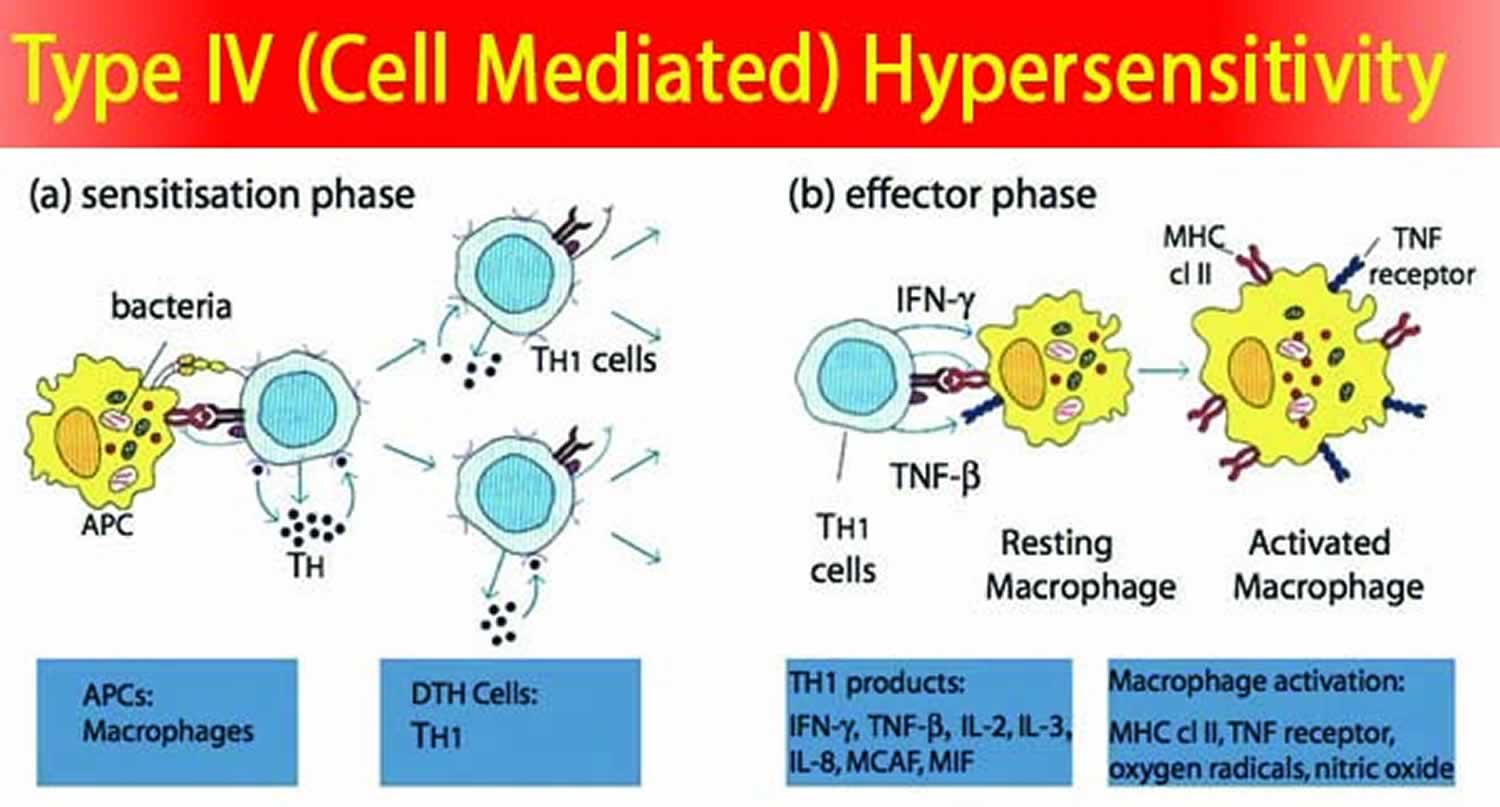Reaction Immune Complex Hypersensitivity. 1 Delayed hypersensitivity plays a crucial role in our bodys ability to fight various intracellular pathogens such as mycobacteria and fungi.

Type Iv Hypersensitivity Delayed Type Hypersensitivity Youtube
Though T cells are believed to orchestrate disease the type of T cell and the location and mechanism of T cell activation remain unknown.

Types of delayed hypersensitivity reactions. This reaction is caused when CD4 Th1 helper T cells recognize foreign antigen in a complex with the MHC class II. Delayed hypersensitivity reaction. Blastomycosis and helminthic infections eg.
Edema of epidermis epidermal organic chemicals poison ivy heavy metals etc tuberculin 48-72 hr local induration lymphocytes monocytes macrophages intradermal. Delayed hypersensitivity reactions Type Reaction time Clinical appearance Histology Antigen and site Contact dermatitis 48-72 hr eczema lymphocytes followed by macrophages. They are distinguished from other hypersensitivity reactions by the lag time from exposure to the antigen until the response is evident 1 to 3 days.
Antibodies do not mediate DHR. DTH Delayed-Type Hypersensitivity response begins with an initial sensitization by antigen followed by a period of at least 1 to 2 weeks. Delayed hypersensitivity reaction also called type 4 hypersensitivity reaction or cell-mediated hypersensitivity reaction is inflammatory reaction initiated by T cells T-lymphocytes and antigen-presenting cells such as macrophages and dendritic cells that cause an inflammatory reaction to either exogenous or autoantigens which takes more than 12 hours.
Clinical care is negatively impacted by a limited understanding of disease pathogenesis. TH1 subtypes CD4 cells activate during the sensitization phase. Type IV hypersensitivity reactions Fig.
Delayed-type drug hypersensitivity reactions dtDHR are immune-mediated reactions with skin and visceral manifestations ranging from mild to severe. Typically the maximal reaction time occurs between 48 to 72 hours. A Type I hypersensitivity b Type II hypersensitivity c Type III hypersensitivity d Type IV hypersensitivity.
Mediated Hypersensitivity Allergy Hypersensitivity. Delayed hypersensitivity DH delayed type hypersensitivity DTH the type of hypersensitivity exemplified by the tuberculin reaction which as opposed to immediate hypersensitivity takes 12 to 48 hours to develop and which can be transferred by lymphocytes but not by serum. Which of the following hypersensitivity occurs via IgE antibody.
Type IV reactions are further subdivided into type IVa IVb IVc and IVd based on the type of T cell CD4 T-helper type 1 and type 2 cells involved and the cytokineschemokines produced. The most widely adopted current classification is that of Coombs and Gell that designates immunoglobulin-mediated immediate hypersensitivity reactions as types I II and III and lymphoid cell-mediated delayed-type hypersensitivitycell-mediated immunity as a type IV reaction. Hypersensitivity is sometimes also called allergy.
Contact hypersensitivity and. Delayed hypersensitivity can be induced by most viral infections many bacterial infections all mycotic. When some subpopulation of activated T helper cells encounters certain antigen they secrete cytokines that induce a localized inflammatory reaction called delayed type hypersensitivity DTH.
Hypersensitivity is of four types. Important diseases include tuberculosis leprosy listeriosis leishmaniasis deep fungal infections eg. It is mediated by T cells that cause an inflammatory reaction to either exogenous or autoantigens.
T-cells or macrophages are activated as a result of cytokine release leading to tissue damage. Type IV hypersensitivity reaction is also known as delayed type hypersensitivity DTH. 46-4 also known as delayed-type hypersensitivity reactions are mediated by antigen-specific effector T cells.
Type IV hypersensitivity is also known as delayed-type and involves of T-cell-mediated reactions. What is sterilization 2 types of sterilization 1. Delayed-type Hypersensitivity DTH T-cell-mediated Cytotoxicity.
T-cells or macrophages are activated as a result of cytokine release leading to tissue damage. The reaction is characterized by influxes of non-specific inflammatory cells particularly macrophages. Coombs and Gel classified type IV hypersensitivity reaction HR as a delayed hypersensitivity reaction DHR which takes more than 12 hours to develop.
DTH reactions are of two types. During this phase antigen-specific T cells activate and clonally expand. Type IV Hypersensitivity Reactions.
Delayed-type hypersensitivity reactions are a prominent feature of several chronic diseases in humans which for the most part are due to infectious agents such as mycobacteria protozoa and fungi. On Immediate and Delayed Hypersensitivity 1 Hypersensitivity reactions are broadly classified into four different types. Unlike the other types it is not antibody-mediated but rather is a type of cell-mediated response.
Type IV hypersensitivity is often called delayed type hypersensitivity as the reaction takes several days to develop. This response involves the interaction of T-cells monocytes and macrophages.
Signs and symptoms of delayed or late-phase allergic reactions are generally the same as those for immediate allergic reactions. The classification and pathogenesis of drug allergies are discussed in detail separately.

Delayed Hypersensitivity Reaction Causes Symptoms Diagnosis Treatment
Hypersensitivity reactions are categorized into four major types.

What is delayed hypersensitivity allergy. A successful readministration protocol. A drug allergy or hypersensitivity reaction is defined as a specific immunologic reaction to a drug. Tuberculin reactions chronic asthma and contact dermatitis are examples of type IV reactions.
Unlike the other types it is not antibody-mediated but rather is a type of cell-mediated response. Delayed hypersensitivity reaction also called type 4 hypersensitivity reaction or cell-mediated hypersensitivity reaction is inflammatory reaction initiated by T cells T-lymphocytes and antigen-presenting cells such as macrophages and dendritic cells that cause an inflammatory reaction to either exogenous or autoantigens which takes more than 12 hours to develop 1. Current Allergy and Asthma Reports.
This reaction is caused when CD4 Th1 helper T cells recognize foreign antigen in a complex with the MHC class II. Delayed hypersensitivity is a common immune response that occurs through direct action of sensitized T cells when stimulated by contact with antigen. These symptoms can cause massive digestive issues autoimmune diseases migraines and moreIdentifying the rectants that cause these symptoms is.
It is referred to as a delayed response in that it will usually require 1224 hours at a minimum for signs of inflammation to occur locally. This response involves the interaction of T-cells monocytes and macrophages. Hypersensitivity reactions HR are immune responses that are exaggerated or inappropriate against an antigen or allergen.
A delayed or delayed allergic reaction also called a delayed allergic hypersensitivity response is an allergic reaction that begins between 24 and 72 hours 1-3 days after exposure to an allergen rather than being an immediate reaction as it occurs usual way in typical allergic reactions. Ann Allergy Asthma Immunol. A type IV hypersensitivity reaction is also called a delayed hypersensitivity reaction because of its delayed appearance ie after 2448 h following challenge in a sensitized individual.
Instead eosinophils monocytes or lymphocytes called T cells are activated by the antigen. Type I type II and type III hypersensitivity reactions are known as immediate hypersensitivity reactions IHR because occur within 24 hours. Multiple drug allergy syndrome.
The epidemiology risk factors diagnosis and management of the most common types of delayed reactions to penicillins will be discussed here. The fourth type is considered a delayed hypersensitivity reaction because it usually occurs more than 12 hours after exposure to the allergen with a maximal reaction time between 48 and 72 hours. Delayed Food Allergy Triggers Although there is no specific cause that behind the occurrence of delayed food allergy in people genetic history of allergies or autoimmune diseases are suspected to support its development.
Immediate-type hypersensitivity reactions due to antituberculosis drugs. In this the allergen introduced into the body and specific IgE is produced which binds to mast cells and basophils. A distinct clinical entity.
Other factors that are believed to trigger the existence of this allergy are. The epidemiology risk factors diagnosis and management of the most common types of delayed reactions to penicillins will be discussed here. This is the classical immediate hypersensitivity reaction.
Type IV hypersensitivity reaction Type IV hypersensitivity or delayed hypersensitivity reaction occurs 4872 hours after exposure to the allergen. Moreover what is delayed type hypersensitivity. A drug allergy or hypersensitivity reaction is defined as a specific immunologic reaction to a drug.
Chronic fungal or bacterial infections. Reidl M Casillas AM. Type IV hypersensitivities are regulated by T cells and are delayed reactions to antigens associated with cells.
This response involves the interaction of T-cells monocytes and macrophages. This reaction does not involve antibodies. Type IV hypersensitivity is often called delayed type hypersensitivity as the reaction takes several days to develop.
Buhari GK et al. The classification and pathogenesis of drug allergies are discussed in detail separately. Delayed hypersensitivity reactions are inflammatory reactions initiated by mononuclear leukocytes.
The term delayed is used to differentiate a secondary cellular. Delayed hypersensitivity deals with negative reactions to foods chemicals molds more two to three days after consumption. Unlike the other types it is not antibody-mediated but rather is a type of cell-mediated response.
Type IV hypersensitivity is often called delayed type hypersensitivity as the reaction takes several days to develop. Coombs and Gell classified hypersensitivity reactions into four forms. The first three types are considered immediate hypersensitivity reactions because they occur within 24 hours.
Delayed or late-phase allergic reactions generally occur 2 6 hours after exposure and even longer in some people.